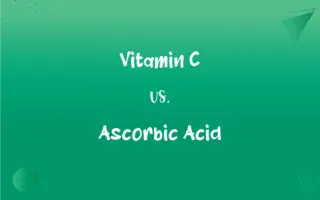Free Ribosomes vs. Attached Ribosomes: What's the Difference?
Edited by Aimie Carlson || By Janet White || Published on January 13, 2024
Free ribosomes synthesize proteins for use within the cell, while attached ribosomes, bound to the endoplasmic reticulum, make proteins for export or membranes.

Key Differences
Free ribosomes are unbound and float freely within the cytoplasm, synthesizing proteins that function within the cell. Attached ribosomes are bound to the endoplasmic reticulum and synthesize proteins destined for secretion or for use in membranes.
The location of free ribosomes allows them to directly release synthesized proteins into the cytosol. In contrast, attached ribosomes release their proteins into the lumen of the endoplasmic reticulum for further processing and transport.
Proteins synthesized by free ribosomes are often those that function in the cytosol, such as enzymes involved in cellular metabolic pathways. Attached ribosomes primarily synthesize proteins that are integrated into cell membranes or secreted from the cell.
Free ribosomes can move around and change their location within the cell, providing flexibility in protein synthesis. Attached ribosomes, however, are stationary, fixed to the endoplasmic reticulum, emphasizing their specialized role in protein synthesis for export.
The presence of free ribosomes is a common feature in all cell types, while attached ribosomes are more prominent in cells specializing in protein secretion, such as pancreatic cells or antibody-producing cells.
ADVERTISEMENT
Comparison Chart
Location
Floating freely in the cytoplasm
Bound to the endoplasmic reticulum
Function
Synthesize proteins for use within the cell
Synthesize proteins for export or membranes
Protein Release
Directly into the cytosol
Into the lumen of the endoplasmic reticulum
Types of Proteins Synthesized
Enzymes for metabolic pathways, internal use
Membrane proteins, secretory proteins
Mobility
Can move within the cell
Stationary, fixed to the endoplasmic reticulum
ADVERTISEMENT
Free Ribosomes and Attached Ribosomes Definitions
Free Ribosomes
Independent ribosomes in the cytosol synthesizing non-secretory proteins.
Free ribosomes are crucial for the production of cytoskeletal proteins.
Attached Ribosomes
Ribosomes fixed on the ER, playing a role in the secretory pathway of the cell.
Proteins entering the Golgi apparatus often originate from attached ribosomes.
Free Ribosomes
Ribosomes not attached to any membrane, floating freely within the cytoplasm.
Free ribosomes synthesize enzymes needed for glycolysis.
Attached Ribosomes
Stationary ribosomes on the endoplasmic reticulum synthesizing secretory proteins.
Insulin is synthesized by attached ribosomes in pancreatic cells.
Free Ribosomes
Unbound ribosomes involved in producing proteins for the cell's cytoplasm.
Free ribosomes play a key role in synthesizing cytoplasmic enzymes.
Attached Ribosomes
Ribosomes on the ER membrane synthesizing membrane-bound proteins.
Membrane receptors are typically synthesized by attached ribosomes.
Free Ribosomes
Ribosomes that can freely change location within the cell.
Free ribosomes move to areas in the cell where protein synthesis is needed most.
Attached Ribosomes
Ribosomes bound to the endoplasmic reticulum involved in synthesizing proteins for export.
Attached ribosomes are busy producing antibodies for secretion.
Free Ribosomes
Cellular structures synthesizing proteins for intracellular use.
Mitochondrial proteins are often produced by free ribosomes.
Attached Ribosomes
Endoplasmic reticulum-bound ribosomes involved in the synthesis of proteins for lysosomes.
Lysosomal enzymes are products of attached ribosomes' synthesis.
FAQs
Can free ribosomes move within the cell?
Yes, they can change location in the cell.
Are attached ribosomes involved in protein secretion?
Yes, they synthesize proteins for export or membrane incorporation.
What are free ribosomes?
Free ribosomes are unattached ribosomes in the cytoplasm, synthesizing proteins for internal use.
What is the role of attached ribosomes in membrane protein synthesis?
They synthesize proteins that become part of cell membranes.
What types of proteins do free ribosomes synthesize?
They synthesize proteins that function within the cell, like enzymes.
Do all cells have free ribosomes?
Yes, all cells contain free ribosomes.
How do free ribosomes release their proteins?
They release them directly into the cytosol.
Where are attached ribosomes located?
Attached ribosomes are located on the endoplasmic reticulum.
Are proteins synthesized by attached ribosomes always secreted?
No, some are integrated into membranes or sent to lysosomes.
Are attached ribosomes larger than free ribosomes?
No, their size is generally similar, but their location differs.
Are free ribosomes visible under a light microscope?
No, they are too small and require an electron microscope to be seen.
Are free ribosomes common in muscle cells?
Yes, as these cells require a lot of enzymes for energy production and muscle function.
Do free ribosomes participate in synthesizing cytoskeletal proteins?
Yes, they play a key role in this.
Do attached ribosomes produce enzymes for the Golgi apparatus?
They produce proteins that may be modified in the Golgi apparatus.
Do both types of ribosomes use mRNA for protein synthesis?
Yes, both use mRNA templates for synthesizing proteins.
Do free ribosomes synthesize nuclear proteins?
Yes, they can synthesize proteins that function in the nucleus.
Can attached ribosomes ever become free ribosomes?
No, their attachment to the ER is a defining characteristic.
Are free ribosomes involved in energy production?
They synthesize enzymes that can be involved in metabolic processes, including energy production.
Can the number of attached ribosomes vary in different cells?
Yes, cells with high secretory functions have more attached ribosomes.
Are the proteins synthesized by attached ribosomes always glycosylated?
Many are glycosylated as part of the processing in the ER and Golgi.
About Author
Written by
Janet WhiteJanet White has been an esteemed writer and blogger for Difference Wiki. Holding a Master's degree in Science and Medical Journalism from the prestigious Boston University, she has consistently demonstrated her expertise and passion for her field. When she's not immersed in her work, Janet relishes her time exercising, delving into a good book, and cherishing moments with friends and family.
Edited by
Aimie CarlsonAimie Carlson, holding a master's degree in English literature, is a fervent English language enthusiast. She lends her writing talents to Difference Wiki, a prominent website that specializes in comparisons, offering readers insightful analyses that both captivate and inform.






































































